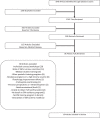A review of published literature on emergency medicine training programs in low- and middle-income countries
- PMID: 23866095
- PMCID: PMC3718616
- DOI: 10.1186/1865-1380-6-26
A review of published literature on emergency medicine training programs in low- and middle-income countries
Abstract
Background: The objective of this review is to identify and critically evaluate the published literature on emergency medicine (EM) training programs in resource-limited health-care settings in order to provide insight for developing EM training programs in such health systems.
Methods: A literature search was conducted up to the end of April 2011 using MEDLINE, EMBASE, The Cochrane Library, EBM Reviews, Healthstar and Web of Science databases, using the following search terms: Emergency Medicine, Emergency Medicine Services, Education Training Residency Programs, Emergency Medical Systems and Medical Education, without limitation to income countries as outlined in the World Bank World Trade Indicators classification 2009-2010 (World Trade Indicators Country Classification by Region and Income, July 2009-July 2010). As the intent of the review was to identify and critically evaluate the literature readily available (published) to LMICs developing EM programs, the gray literature was not searched.
Results: The search yielded 16 articles that met the final inclusion criteria. As the majority of articles provide a narrative description of the processes and building blocks used in developing the residency programs reported, we present our results in narrative format. By providing a summary of the lessons learned to date, we hope to provide a useful starting point for other resource-limited settings interested in establishing emergency medicine specialty training programs and hope to encourage further information exchange on this matter.
Conclusions: The results of the review indicate that EM training is in its infancy in resource-constrained health-care systems. There are few detailed reports of these programs successes and limitations, including efforts to optimize graduate retention. Despite the paucity of currently published data on the development of EM residency training programs in these settings, this review demonstrates the need for encouraging further information exchange to aid in such efforts, and the authors make specific recommendations to help guide future authors on reporting on such efforts.
Figures
References
-
- Mills EJ, Kanters S, Hagopian A, Bansback N, Nachega J, Alberton M. et al.The financial cost of doctors emigrating from sub-Saharan Africa: human capital analysis. BMJ. 2011;6:d7031. doi: 10.1136/bmj.d7031. http://www.bmj.com/content/343/bmj.d7031. PMID: 22117056. - DOI - PMC - PubMed
-
- Boutayeb A. The double burden of communicable and non-communicable diseases in developing countries. Trans R Soc Trop Med Hyg. 2006;6(3):9. Epub 2005 Nov 4. Review. PubMed PMID: 16274715. - PubMed
-
- World Trade Indicators Country Classification by Region and Income, (July 2009-July 2010) http://siteresources.worldbank.org/INTRANETTRADE/Resources/239054-126108....
-
- Jalili M, Holliman CJ. Development of the emergency medicine curriculum at the national level: another forward step toward establishment of emergency medicine in Iran. J Emerg Med, Trauma and Acute Care. 2008;6(3):145–147.
LinkOut - more resources
Full Text Sources
Other Literature Sources
Research Materials
Miscellaneous


